Exercises for Kids at
For Children (Age 12 and Younger)
For both boys and girls, it is important to engage in exercises for kids that require walking, jumping, running, skipping, hopping, catching, and climbing to aid in developing their balance, agility, and coordination. Movements such as these will also allow for their natural growth spurts and patterns to occur.
I recommend a minimum of 4 days per week of cardiovascular activities. Kids should move for 30 minutes per day, and up to 7 days a week is acceptable. These activities can be done through group sports or as general play.
Baseball, soccer, basketball, touch football. These are great if your child is a "joiner" and likes organized activities. Adult supervision and coaching are excellent, though it's even better if you or your husband can help coach.
Dodgeball. This is a very fun game, but kids need to be careful.
Tag. Kids can play this old standby for hours. They have no idea how much exercise they are getting, because they are having so much fun. It's a great game if kids have lots of neighborhood friends.
Trampoline. Kids should be careful and do this only with adult supervision and with adults serving as spotters. It's a great activity for building up endurance and leg muscles.
Climbing. Find some little hills or paths out in the parks for great fun. Monkey bars are great for upper-body muscle development and keep kids entertained for hours.
Skateboarding. Skateboarding is great for the legs and cardiovascular health. Kids must always wear helmets and must go only on sidewalks -- never on the street. Make sure they check for cars going in and out of driveways.
Jump rope. Jumping rope gets the heart beating and is great for leg strength. You don't need a big yard, and you can even do it indoors.
Roller skating, ice skating. Roller and ice skating are great cardio activities, and kids love them.
Bowling. Bowling builds great coordination and arm strength, and it's fun for kids and parents alike.
Martial arts. Many kids are starting martial arts at very early ages. Judo and karate are a great form of exercise for kids and teach them great discipline, self-control and self-confidence.
Check your local YMCA, YWCA, and park districts for classes and events. Whatever activities you choose, supervision and proper instruction are always recommended. It's okay to ask your children what they like to do -- discover what they consider to be fun. This is also a way of finding out what sports or activities they might naturally excel at. Watch out for those future Olympians! If they can't decide, feel free to suggest a daily activity and provide them with the necessary environment.
Fit Family Activity
At one time during the week, I want everyone in your family to participate in one family activity for 30 minutes.
Generally, you can do whatever you want for your weekly family fun as long as it involves the entire family and is healthy, and you have a good time. It should be something easy that puts the family together and begins to reinforce good habits around this weekly event.
I recommend going to a park with a soccer ball and having a family soccer game. Regardless of where you live, there are plenty of park areas where you and your entire family can meet and do lots of things. If you can't find any goals, use some trashcans or plastic cones to make goals, and have a blast. Everyone loves to kick a ball.
Spend as much time as you like playing, but no less than 30 minutes. Have scoring contests with one another. See who can head the ball into the net, who can dribble the farthest, and who can kick the farthest, or have a parents versus kids game. Be creative, and you will have fun and lots of laughs. And don't forget to give yourself and your family small rewards for their healthy efforts; maybe a trip to the movie theater or some extra time staying up on the weekends. It will go a long way.
If it's raining or too cold outside, find an indoor rock climbing wall and have the whole family try to climb. Rock climbing develops hand grip and all upper body muscles, and it's a great confidence booster. Climbing on an indoor wall is safe and fun for the whole family, but be sure to have proper instruction before starting.
For children, I recommend doing exercises that concentrate on pushing with their upper bodies, sitting and standing with their legs, using their arms and shoulders, and balancing on their feet. Along with their cardiovascular activities, boys and girls need just a little bit of resistance that will enable these foundation muscles to grow stronger. Kids 12 and under are too young to be lifting "weights." Misused and/or misguided weight lifting can possibly interfere with growth patterns or cause serious injury. Wait until your child is 13 or older to start using weights of any kind—:and always provide proper instruction.
I recommend 2 days per week of strength-training exercises, doing one set of each exercise. Follow the number sequence to complete one go-round, or "circuit." Do 10 repetitions per exercise. Simply have your child follow the sequence of numbers from 1 to 7 to complete a full exercise session. Have your child complete all seven exercises at least once for a full workout. Kids should do anywhere from 1 to 10 repetitions, depending on their abilities. If your child is capable and wants more of a challenge, he can repeat the circuit of all seven exercises a second and even a third time, keeping the repetitions at 10. Check your child's form at all times and seek professional guidance if needed.
#1 Pushup
(Chest, shoulders, triceps)
Here's how: Start by kneeling on the floor with your knees together. Lean forward and place your hands about shoulder width apart. With your feet in the air, slowly lower your body as you inhale. Stop when your elbows are at 90 degrees, pause, then push back up to the starting position as you exhale. Keep your upper body straight at all times.
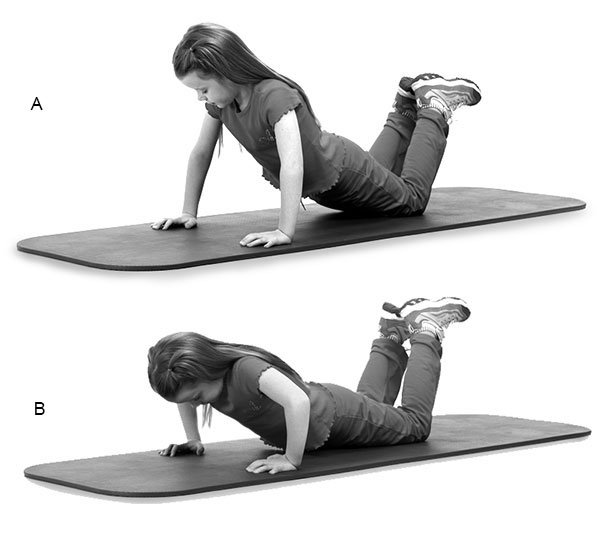
(Back, buttocks)#2 Back Extension
Here's how: Start by lying facedown on the floor with your arms at your sides, legs slightly apart and eyes open. Slowly lift your head, neck and shoulders as far as you can as you exhale, then return to the starting position as you inhale. Don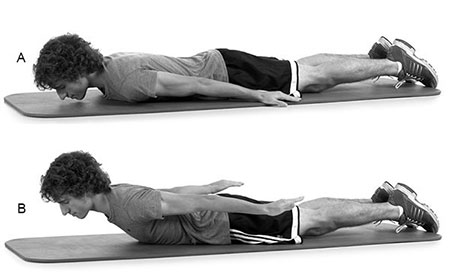
#3 Biceps Curl
(Biceps)
Here's how: Start by holding a light medicine ball or a rubber tube in your hands in front of your body, with your knees soft and feet shoulder width apart. Slowly curl the ball or tube up toward your chest, keeping your elbows at your sides as you exhale. Pause at the top, then return to the starting position as you inhale.
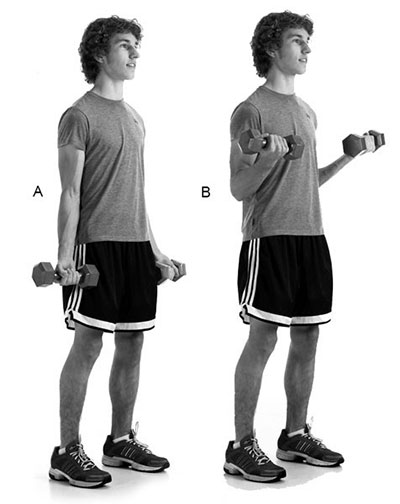
#4 Overhead Press
(Shoulders, triceps)
Here's how: Start by holding a medicine ball at chest height, with your knees soft and feet shoulder width apart. Slowly press the ball overhead as you exhale. Pause at the top, then slowly return to the starting position as you inhale.
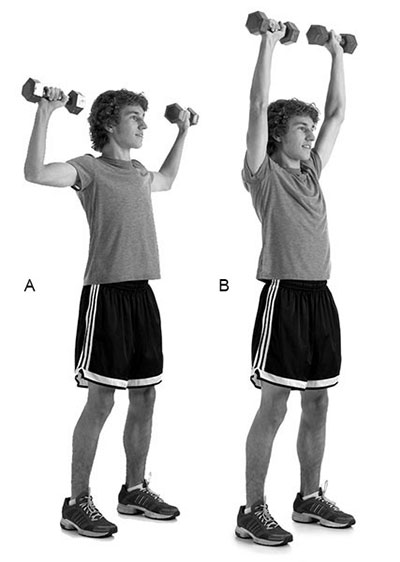
#5 Sit/Stand Chair Exercise
(Legs, hips)
Here's how: Use a chair or step stool that you have to bend down to sit on. Stand approximately 6 inches in front of the chair. Slowly start to squat down toward the chair seat, keeping your chest up, back straight and arms straight out in front of you as you inhale. Pause when the backs of your thighs or buttocks touch the chair, then return to the starting position as you exhale.
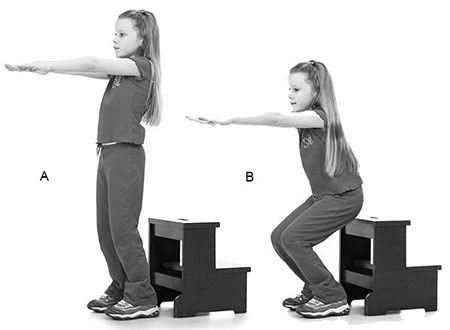
#6 Abdominal Crunch
(Abdominals, lower back)
Here's how: Start by lying faceup on the floor, with your knees bent and feet flat and shoulder width apart. With your arms stretched out over your knees, slowly squeeze your stomach muscles and lift your head, neck and shoulders off the floor as you exhale. Come up only about 6 inches, pause, and return to the starting position as you inhale.
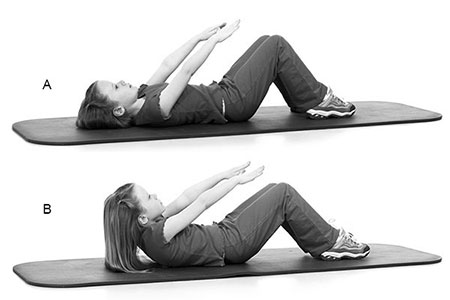
#7 One-Leg Balance
(Legs, hips—ankle/knee stabilizers)
Here's how: Stand tall, with your feet 2 inches apart, shoulders back, chest up and eyes open, facing straight ahead. Slowly lift one leg and bend the knee at 90 degrees. Keep the other knee soft, never locked. Pause, then return to the starting position. Repeat on the other side. Breathe normally throughout.

Remember to always exercise in a safe, open area. Use a reward system for effort and a job well done. Whether its a raise in allowance, sleeping over at a friends house or a trip to an amusement park, it will reinforce your childrens understanding of these healthy habits. They don't need a reward every day, but maybe on a weekly basis.
Excerpted from Lean Mom, Fit Family: The 6-Week Plan for a Slimmer You and a Healthier Family by Michael Sena, CFS, with Kirsten Straughan, RD, LD, and Tom Sattler, EdD © 2005. Permission granted by Rodale Inc.
-
Weight Loss: Abs Diet Plan Summary
(Editors note: This excerpt was take from the new Abs Diet book, The G
-
10 (Painless) Ways to Upgrade Your Diet
Lower Your Blood Pressure and Cholesterol How: Eat shiitakes and
-
Diet Strategies: TV and Childhood Obesity
Television may be a parents best babysitter, but it comes with a hefty
-
Weight Loss Success Stories: Biking
Finding a good workout buddy can be harder than lifting the weights th
-
Diet Str egies: Muscle-Building Meal Plan
The meals in this 1-day plan total 2,300 calories. If youre a 200-poun
-
Eat MORE to LOSE More!
I got off the phone with a friend the other day who had a few question




